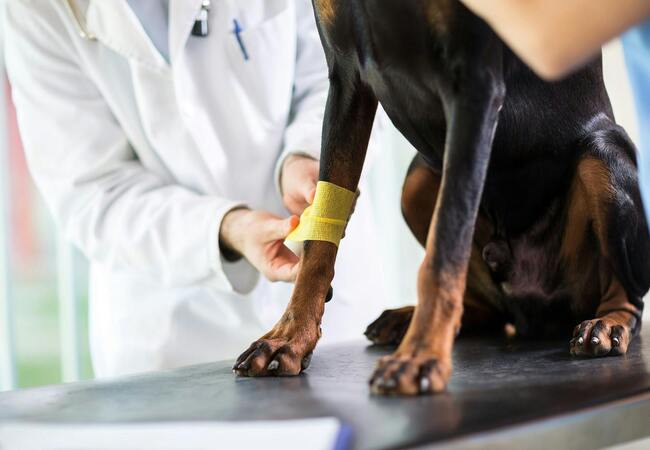Vet’s 2025 Guide to Canine Septic Arthritis 🩺 Diagnosis, Treatment & Recovery

In this article
Vet’s 2025 Guide to Canine Septic Arthritis 🩺 Diagnosis, Treatment & Recovery
By Dr. Duncan Houston BVSc
💡 What Is Septic Arthritis?
Septic arthritis is an infection within a joint caused by bacteria, fungi, or rarely, viruses. It leads to inflammation, pain, swelling, and, without prompt intervention, cartilage destruction or systemic sepsis.
🚩 Who’s at Risk & How It Happens
- Occurs across all ages—puppies may develop spontaneous septic arthritis; large breeds, males, and older dogs are more frequently affected.
- Infection spreads into the joint via:
- Hematogenous spread from pneumonia, UTI, skin, or gastrointestinal infections.
- Direct penetration: wounds, bite wounds, surgery or injections.
- Any joint can be affected, but elbows and stifles are common sites in dogs.
👀 Signs & Symptoms
- 🦴 Acute lameness, joint heat, swelling, pain on manipulation—may be single or multiple joints.
- Systemic signs: fever, lethargy, reduced appetite.
- Joint effusion may be seen as visible swelling on exam or via imaging.
- Puppies: acute non-weight-bearing lameness, painful swollen joints, systemic illness.
🧪 Diagnostic Steps
A structured approach ensures swift diagnosis:
- Physical exam & history: palpate for pain, swelling, joint warmth; assess for fever or concurrent infections.
-
Imaging:
• X‑rays — used to exclude fractures, osteomyelitis, or developmental disease; may show joint distension in early stages.
• Ultrasound — detects effusion, abscess pockets; can assist guided aspiration.
• CT/MRI — useful if deeper tissues or bone involvement is suspected. -
Arthrocentesis & synovial fluid analysis:
• Cytology — typically shows high neutrophil count, sometimes intracellular bacteria.
• Culture & sensitivity — helps target antibiotic therapy; note that prior antibiotic use may reduce culture yield (~44% in studies).
• In-house cytology supports rapid diagnosis and early treatment. - Bloodwork & cultures: CBC, biochemistry, blood cultures if systemic signs present.
- Surgical debridement is reserved for cases with bone involvement or abscess formation.
- Cultures guide whether further surgical intervention is needed.
2. Empirical to Targeted Antibiotic Therapy
- Start broad-spectrum IV antibiotics (e.g., cefuroxime, amoxicillin-clavulanate) within first 24–48 hrs.
- Switch to oral antibiotics based on culture; total 4–8+ weeks depending on severity.
- Long-term therapy is critical to prevent recurrence or chronic joint damage.
3. Pain Management & Supportive Care
- NSAIDs (like meloxicam) or opioids used short-term to manage pain.
- IV fluids if febrile or systemically affected.
- Physiotherapy initiated early to preserve range of motion and prevent stiffness or degenerative changes.
4. Hospitalization & Close Monitoring
- In-hospital care may be necessary early on for IV antibiotics, pain control, aspiration, and monitoring.
- Re-evaluation of joint fluid and clinical signs is done during therapy to confirm improvement.
📈 Prognosis & Complications
- Prompt treatment often leads to full recovery; many dogs show improvement within 24 hours and soundness by 7 days.
- Possible long-term issues: osteoarthritis, joint stiffness, degeneration if damage is severe or treatment delayed.
- Prognosis is guarded if systemic illness, resistant bacteria, or delayed treatment; mortality rates in humans highlight importance of timely care.
- Recurrence occurs in some cases—continued monitoring and joint care is advised.
🚫 Prevention Tips
- Clean and promptly treat any wounds near joints.
- Routine dental hygiene and infection control reduce hematogenous spread.
- Minimize risk of bites and thorn injuries.
- Regularly screen and treat underlying infections like UTI or pneumonia.
🏡 Ask A Vet Home Care Support
- 🗓 Set medication reminders—antibiotic schedules, NSAID dosing, joint check-ins.
- 📸 Upload photos or videos tracking swelling, gait, and comfort levels.
- 📊 Use logs to monitor pain, appetite, mobility, and fever.
- 🔔 Receive alerts for signs of relapse or complications (e.g. fever, lameness)
- 📚 Access rehab guides—bath exercises, joint stretches, safe activity plans
🔑 Key Takeaways
- Septic arthritis is a serious, painful joint infection needing rapid treatment.
- Diagnosis relies on physical exam, imaging, and synovial fluid cytology/culture.
- Treatment includes antibiotics, lavage or surgery, pain management, and rehab.
- Outcome depends on early intervention; long-term joint health may require ongoing care.
- Ask A Vet app supports structured recovery with reminders, monitoring, and rehab guidance.
🩺 Final Thoughts ❤️
In 2025, the prognosis for canine septic arthritis is brighter thanks to fast diagnostics, advanced imaging, targeted treatment, and robust support systems. With early veterinary intervention and diligent home care through Ask A Vet, most dogs can recover well and maintain joint health. Stay alert, act swiftly, and use every tool available to safeguard your pup’s future comfort and mobility. 🐾✨
Visit AskAVet.com and download the Ask A Vet app to set treatment schedules, upload joint photos, track progress, schedule follow-ups, and stay connected with expert veterinary support—right from home. 📲






